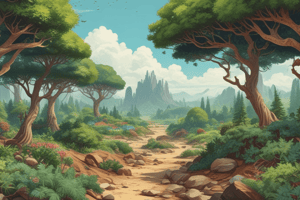Podcast
Questions and Answers
What is a biome in biology and geography?
What is a biome in biology and geography?
- A large landmass with diverse topography and weather patterns
- A collection of different habitats within a particular region
- A geographic region with similar climate, vegetation, and fauna (correct)
- A specific ecosystem with unique species composition
What are the most important abiotic factors used to characterize biomes?
What are the most important abiotic factors used to characterize biomes?
- Topography and weather patterns
- Soil type and amount of sunlight
- Temperature and precipitation (correct)
- Humidity and wind speed
Why do all tropical rainforest biomes receive high amounts of sunlight and rainfall all year round?
Why do all tropical rainforest biomes receive high amounts of sunlight and rainfall all year round?
- Because of their proximity to large bodies of water
- Because of the presence of dense cloud cover
- Due to their location near the equator (correct)
- As a result of their high altitude
What is an example of a biome found on every continent?
What is an example of a biome found on every continent?
What are the components that make up a biome?
What are the components that make up a biome?
Which statement best describes the classification of biomes?
Which statement best describes the classification of biomes?
What distinguishes the Great Smoky Mountains as a biome?
What distinguishes the Great Smoky Mountains as a biome?
Which feature distinguishes the Amazon Rainforest as a biome?
Which feature distinguishes the Amazon Rainforest as a biome?
What is a defining characteristic of San Francisco Bay as a biome?
What is a defining characteristic of San Francisco Bay as a biome?
How are biomes named and classified?
How are biomes named and classified?
Flashcards
What is a biome?
What is a biome?
A geographic region defined by its climate, vegetation, and animal life.
Key abiotic factors of biomes?
Key abiotic factors of biomes?
Temperature and precipitation are most important.
Why tropical rainforests are wet?
Why tropical rainforests are wet?
Located near the equator, resulting in consistent sunlight and rainfall.
Biome on every continent?
Biome on every continent?
Signup and view all the flashcards
Biome components?
Biome components?
Signup and view all the flashcards
Biome classification?
Biome classification?
Signup and view all the flashcards
Great Smoky Mountains biome?
Great Smoky Mountains biome?
Signup and view all the flashcards
Amazon Rainforest as a biome?
Amazon Rainforest as a biome?
Signup and view all the flashcards
San Francisco Bay biome?
San Francisco Bay biome?
Signup and view all the flashcards
How biomes are named?
How biomes are named?
Signup and view all the flashcards
Study Notes
Biomes and Their Classifications
- Biomes are named after the prominent vegetation found in the region, such as the grassland biome known for its open grass.
- There is a debate among scientists about the number and definition of biomes, with some recognizing 5-6 major types and others suggesting over 20.
- Biomes can be broadly divided into terrestrial biomes and aquatic biomes.
- Terrestrial biomes include rainforests, grasslands, coniferous forests, temperate deciduous forests, deserts, tundra, and shrublands.
- The seven major terrestrial biomes are characterized by distinct temperature and precipitation patterns.
- Aquatic biomes include freshwater, wetlands, marine, coral reef, and estuaries, each with unique characteristics.
- Real-world examples of biomes include the Amazon Rainforest, the Great Smoky Mountains, the Great Barrier Reef, and San Francisco Bay.
- The Amazon Rainforest, the largest rainforest biome, covers over 2.3 million square miles and is located in South America.
- The Great Smoky Mountains contain a temperate deciduous forest biome with distinct seasonal changes.
- The Great Barrier Reef, the largest coral reef biome, is located off the coast of Australia and is highly biodiverse.
- San Francisco Bay is a large estuary biome on the west coast of the United States, characterized by brackish waters from the convergence of freshwater and saltwater.
- Biomes are classified based on vegetation, temperature, and precipitation, and can be found on multiple continents worldwide, including in the United States.
Studying That Suits You
Use AI to generate personalized quizzes and flashcards to suit your learning preferences.




